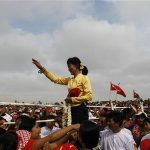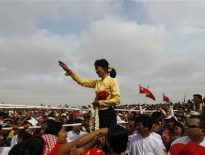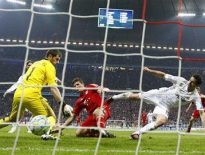By Douglas
Hamilton
BEIRUT (Reuters) – A United Nations mission to oversee an end to violence in Syria may need to bring in its
own aircraft and deploy more troops to ensure that a firm ceasefire takes hold throughout the country, U.N. Secretary General
Ban Ki-moon said on Tuesday.

boy gestures as he stands in front of the fence at Yayladagi refugee camp in Hatay province near the Turkish-Syrian border
April 17, 2012. REUTERS/Umit Bektas
A six-day-old
truce has held in some parts of Syria since President Bashar al-Assad pledged to enforce it last week. But in strong
opposition areas such as Homs, Hama, Idlib and Deraa the army continues to attack and battle rebels, using heavy weapons in
violation of the pledge by Damascus to pull back.
After negotiations led by former U.N. Secretary General Kofi Annan
acting as envoy of the United Nations and Arab League, Assad’s government has agreed to allow a small U.N. force to monitor
the ceasefire.
But the planned 250-strong mission is a fraction of the size of U.N. peacekeeping forces sent to other
conflicts, raising doubt among Assad’s opponents about whether it can be effective or will serve as a figleaf substitute for
more robust action.
Annan delivered a status report to Arab League ministers, who called on Assad to let the U.N.
observers do their job.
“We fully support Mr Annan and his six-point plan, but sadly, the killing still goes on,”
Qatari Prime Minister Sheikh Hamad bin Jasim bin Jabr al-Thani told reporters after the meeting. “We are fearful that the
regime is playing for time. We expressed this to Mr Annan.”
U.N. Secretary-General Ban said the ceasefire was being
“generally observed” although there was still violence. But the 250 observers would be “not enough considering the current
situation and the vastness of the country”.
He said in Luxembourg that the U.N. was asking the European Union to
provide helicopters and planes for the operation, which he would propose formally to the Security Council on
Wednesday.
It was not clear whether Assad would agree to allow more U.N. troops and foreign aircraft into the country.
A political source in neighbouring Lebanon said Damascus had already refused the use of U.N. helicopters.
The protocol
for the mission – which must have Syrian consent – is being worked out in Damascus by a team of U.N. peacekeeping
officers.
Monitors also made an exploratory trip outside the capital.
“A group of international observers
visited Deraa in the south of Syria today,” U.N. spokesman Khaled al-Masri said. “They met the governor and toured the
city.”
Deraa is where the revolt against Assad began in March 2011. the city and surroundings have experience extreme
violence.
The U.S. envoy to the United Nations, Susan Rice, said the “wisdom and the viability of sending in the full
monitoring presence” of 250 would be in question if violence did not stop.
An Arab League monitoring mission was
aborted in January after just a month in country because of daily shooting and shelling. But during its short life it
emboldened Syrians to resume anti-Assad street protests – an effect the government will not want to see repeated.
The
Syrian Observatory for Human Rights, relaying reports from anti-Assad activists, said three people were killed and dozens
wounded by shelling on Tuesday, two of them as troops sought to take control of Basr al-Harir in the southern province of
Deraa. Activists say the town has been a rebel stronghold.
In the northern Idlib province, the army fired mortars and
machine guns in two villages, killing four people. Army mortars pounded targets in the Khalidiya and Bayada districts of
Homs, where the artillery assault resumed on Saturday two days after the truce came into force. Streets of Homs held by
rebels earlier this year now resemble scenes from World War Two.
Assad, who agreed the peace plan with Annan more than
three weeks ago, has not yet fulfilled its primary demand – that tanks, troops and big guns be withdrawn from populated areas
and all forms of violence cease.
The Observatory said 23 people were killed on Monday, the first day of work for the
U.N. advance team of six.
Qatar and Saudi Arabia say it is time to arm the Free Syrian Army with weapons to combat
Syria’s powerful, Russian-armed forces. But other Arab League states say this would tip the crisis into all-out civil war
threatening the wider region.
The West has shown no desire to intervene militarily or push for the sort of robust
peacekeeping mission that would likely require at least 50,000 troops. Russia and China have made clear they would block a
U.N. mandate to use force.
250 MONITORS “NOT ENOUGH”
The small U.N. team, led by Moroccan colonel Ahmed
Himmiche and including General Abhijit Guha, the Deputy Military Adviser in the U.N. Department of Peacekeeping Operations,
is operating from an existing U.N. office in Damascus.
The Assad government says that – as with the Arab League
operation – all of the unarmed U.N. mission’s “steps on the ground” must be coordinated with the state for its own
safety.
Ban confirmed that he would ask for 250 monitors, despite believing that it was insufficient.
“That is
what I am going to propose to the Security Council … there is always the question whether 250 is enough. I think it is not
enough considering the current situation and the vastness of the country.”
“That is why we need very efficient
mobility of our mission. That is what I have discussed with EU (leaders) yesterday … whether the EU could provide all these
assets for mobility including helicopters and planes …,” Ban said.
Diplomats say Annan’s main aim is to get a U.N.
mission on the ground backed by Syria’s supporters Russia and China, even if it is not big enough at first to do the job.
Critics say Assad will simply play with U.N. politics to gain time.
MISSING MISSION CHIEF
Colonel Himmiche is
the second U.N. peacekeeping officer to lead a team to Syria. Norwegian General Robert Mood took a team in on April 5 and
returned to brief Annan on April 10. He has not appeared publicly since, leading to speculation that he was disassociating
himself from a mission he could not endorse.
“The mystery of the missing mission chief” needs to be cleared up, the
Beirut Daily Star said on Tuesday. If he was unwilling to lead a mission of limited reach and under Syrian control “it is
crucial now for Mood to speak up”, it said.
A Western diplomat said Mood is still the leading candidate to become the
head of the full mission when it is deployed. Annan’s spokesman Ahmad Fawzi said Mood was a “good candidate” for the job but
the decision had not been taken yet.
Syria blames a year of escalating violence on “terrorists” seeking to topple
Assad. It restricts independent journalists’ access to the country, making it hard to verify reports.
The U.N. says
Syrian forces have killed more than 9,000 people in the uprising. Syrian authorities say foreign-backed militants have killed
more than 2,600 soldiers and police.
Annan’s plan calls for political dialogue to end the crisis.
“There are
those who want Kofi Annan’s plan to fail,” Russian Foreign Minister Sergei Lavrov said without naming anyone. “They are
doing this by delivering arms to the Syrian opposition and stimulating the activity of rebels”.
Lavrov is critical of
Western and Arab states backing the Syrian opposition-in-exile in the Friends of Syria group.
France said it would
host a foreign ministers meeting of the group on Thursday in Paris, including U.S. Secretary of State Hillary Clinton, to
discuss the fragile ceasefire in Syria.
Western sanctions have halved Syria’s foreign reserves and should be stepped
up to force Damascus to comply with the U.N.-backed peace plan, France’s Foreign Minister Alain Juppe told officials from 57
countries meeting in Paris.
(Additional reporting by Dominic Evans and Oliver Holmes in Beirut, Arshad Mohammed in
Brasilia, Steve Gutterman in Moscow, Lou Charbonneau at the UN in New York, Rex Merrifield in Luxembourg.; Writing by Douglas
Hamilton; Editing by Peter Graff)





